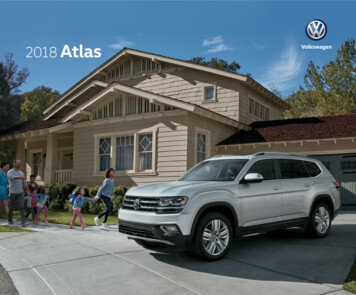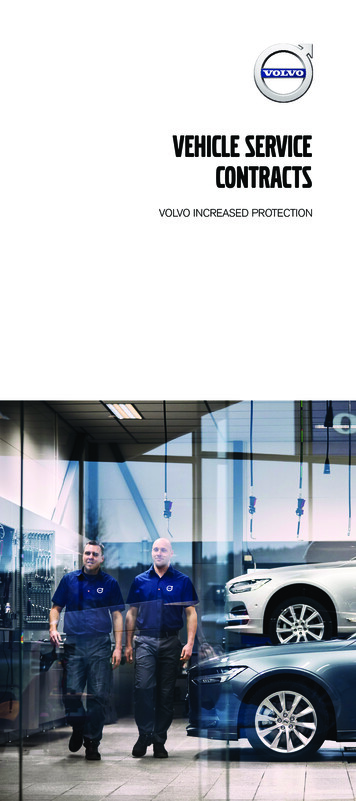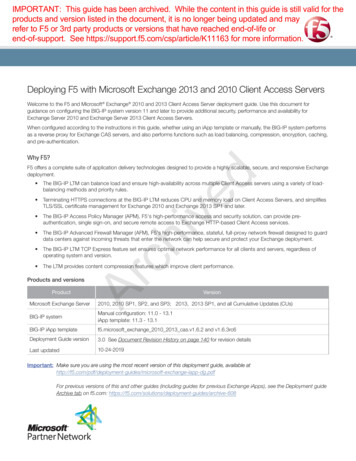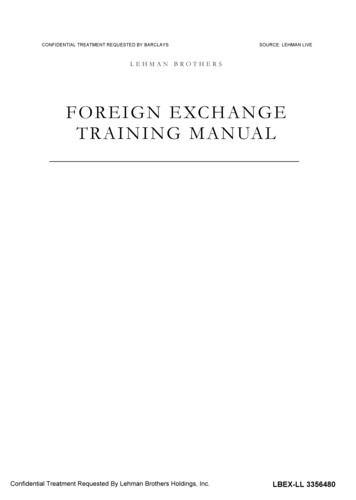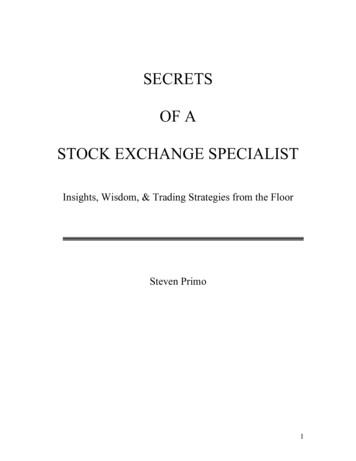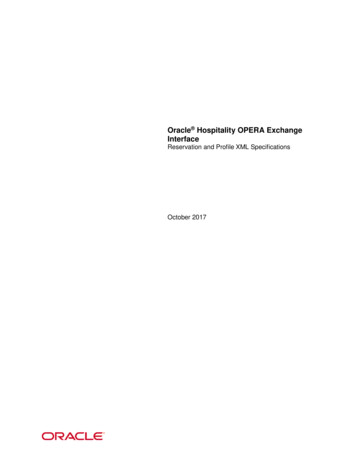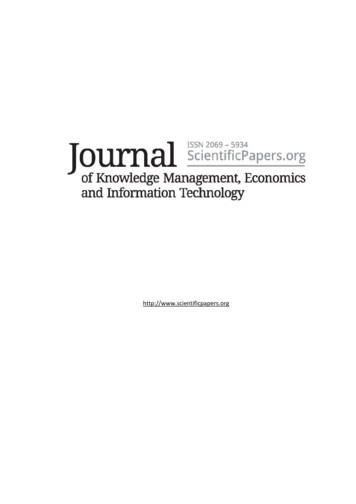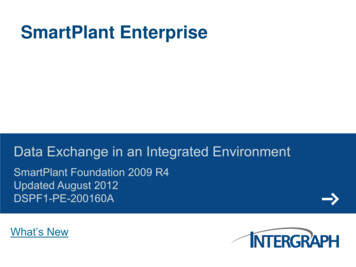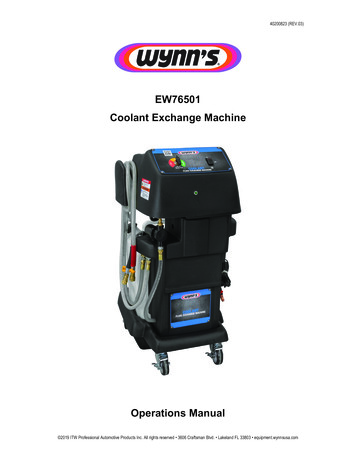
Transcription
40200823 (REV.03)EW76501Coolant Exchange MachineOperations Manual 2019 ITW Professional Automotive Products Inc. All rights reserved 3606 Craftsman Blvd. Lakeland FL 33803 equipment.wynnsusa.com
TABLE OF CONTENTSINTRODUCTION TO THE MACHINE . 2CUSTOMER SERVICE CONTACT INFO . 2SAFETY INFORMATION . 3MACHINE SPECIFICATIONS & FEATURES . 9MACHINE OVERVIEW . 10OPERATING INSTRUCTIONS . 11MAINTENANCE . 15REPLACEMENT PARTS . 16WARRANTY INFORMATION . 18 2019 ITW Professional Automotive Products Inc. All rights reserved 3606 Craftsman Blvd. Lakeland FL 33803 equipment.wynnsusa.com
INTRODUCTION to theWynn’s Coolant MachineCongratulations on the purchase of your Wynn’s Coolant Machine!This is a device that removes and refills engine coolant and also pressure teststhe cooling system. Coolant is extracted and refilled through the upper radiatorhose connection without the vehicle’s engine running.Simply put, this machine is the cleanest, safest and most thorough method ofradiator fluid exchange ever devised. Suddenly, cooling system maintenance hasbecome a more realistic proposition. Fluid exchanges are cleaner and neaterthan ever!Service neglect causes engine coolant to break down which can lead to theengine freezing or overheating. Historically, cooling system fluid service hasbeen neglected, often due to the lack of a convenient method for providing suchflush or fluid exchange services. Previous methods for exchanging the coolingsystem or replacing the coolant were time consuming and often inefficient orincomplete. Now, it’s easier than ever to replace virtually all of the old coolant inless than 8 minutes, to ensure your car’s cooling system has a long, trouble-freelife.Please take time to read through this manual to familiarize yourself with themachine before performing your first coolant exchange.CUSTOMER SERVICE CONTACT INFORMATIONFor product information, tech support, or to order replacement parts,please call: 833-303-4644or visit: equipment.wynnsusa.com1
IMPORTANT SAFETY NOTICEFor your safety, read this manual thoroughly before operating this machine. This machineis intended for use by properly trained, skilled professional automotive technicians. Thesafety messages presented below and throughout this user’s manual are reminders to theoperator to exercise care when using this unit. Before using this machine, always refer toand follow the safety messages and applicable service procedures provided by themanufacturer of the vehicle being serviced. Read All Safety InstructionsRead, understand and follow all safety messages and instructions in this manual. Safetymessages in this section of the manual contain a signal word with a three-part messageand, in some instances, an icon. Signal WordsThe signal word indicates the level of the hazard in a situation:Indicates an imminently hazardous situation which, if not avoided,will result in death or serious injury to the operator or to bystanders.Indicates a potentially hazardous situation which, if not avoided,could result in death or serious injury to the operator or to bystanders.Indicates a potentially hazardous situation which, if not avoided,may result in moderate or minor injury to the operator or to bystanders.Indicates a situation which, if not avoided, may result in damageto the machine, or the vehicle being serviced. Safety MessagesSafety messages in this section contain three different type styles: Normal type states the hazard. Bold type states how to avoid the hazard. Italic type states the possible consequences of not avoiding the hazard.2
Safety SymbolsA safety symbol, when present, gives a graphical description of the potential hazard,and how to avoid the hazard:3Risk of FireRead Instructions Before UseRisk of ExplosionMandatory Eye ProtectionRisk of EntanglementMandatory Protective GlovesDangerous FumesMandatory Protective ClothingDo Not Pull or MoveRisk of Burns
IMPORTANT SAFETY INSTRUCTIONSEngine exhaust contains toxic gases. Vent vehicle’s exhaust away from work area. Do not breathe exhaust.Exhaust gases will cause injury or death.Improper use and operation. Read, understand and follow all safety messages and operational procedures in thismanual before operating this machine. This equipment should be operated only by qualified personnel. Use this equipment only as described in this manual.Improper use and operation of this product can result in injury.Engine systems can malfunction expelling fuel, oil vapors, hot steam, hot toxic exhaust gases andother flying particles. Wear safety goggles and protective clothing, user and bystander. Everyday eyeglassesonly have impact resistant lenses; they are NOT safety glasses. Do not position head directly over or in front of carburetor or throttle body. Enginebackfire can occur when air cleaner is out of normal position. Make sure gauge reads zero before connecting or disconnecting hose connections toadapters. Make sure cooling system pressure has been relieved before connecting ordisconnecting hose connections and adapters. Keep a dry chemical (Class B) fire extinguisher rated for gasoline, chemical & electricfires in the work area.Fire, explosion, or flying particles may cause serious injury.Risk of expelling pressurized fluids. Wear safety goggles and protective clothing, user and bystander.4
Engine systems can malfunction, expelling fuel, oil vapors, hot steam, hot toxic exhaustgases and other debris. Always unplug the machine from its power source when not in use. Keep the service hoses away from hot or moving engine parts. Hoses can split or burstcausing fluid to be expelled. Avoid contact with engine coolant. Treatment methods are as follows:Eyes: Flush eyes with plenty of water.Skin: Wash with soap and water.Inhalation: Move to uncontaminated area.Ingestion: If large amount, get medical attention.If any irritation persists, get medical attention. Dispose of used fluid according to environmental laws and regulations.Fuel, oil vapors, hot steam, hot toxic exhaust gases, pressurized fluid, and other debris can causeserious injury.Risk of unexpected vehicle movement. Block drive wheels before starting vehicle’s engine to begin an exchange. Unless instructed otherwise, set parking brake and put gear selector in park. Do not leave a running vehicle unattended. If vehicle has an automatic parking brake release, disconnect release mechanism fortesting and reconnect when testing is completed.A moving vehicle can cause injury.Risk of entanglement. Engine has moving parts. Do not place tools on fenders or other places in engine compartment. Keep yourself, clothing, battery cables and service hoses clear of moving parts such asfan blades, belts, pulleys, hood and doors. Barriers are recommended to help identify danger zones in test area. Prevent personnel from walking through immediate test area.Contact with moving parts can cause injury.Risk of fire or explosion. Do not operate in the vicinity of open containers of flammable liquids such as gasoline. Keep hoses and jumper cables away from heat sources and sharp edges. Do not operate equipment with damaged cords or hoses until they have been examinedby a qualified serviceman.Fire or explosion can cause injury.5
Risk of fire or explosion. Gases produced by a battery are highly explosive. Wear safety goggles and protective clothing, user and bystander. Do not smoke, place metal tools on battery or allow a spark or flame in vicinity of battery.Battery explosion can cause injury.Risk of burns. Wear gloves when handling hot engine components. Do not remove radiator cap unless engine is cold. Pressurized engine coolant may be hot. Do not touch hot exhaust systems, manifolds, engines, radiators, etc.Hot fluid and engine parts may cause injury.Battery acid is a highly corrosive sulfuric acid. Wear safety goggles and protective gloves, user and bystander. Have plenty of fresh water and soap nearby. If battery acid contacts skin, clothing, oreyes, flush exposed area with soap and water for 10 minutes. Do not touch eyes while working near battery.Battery acid can burn eyes and skin.Risk of burns. Wear gloves when working near hot engine components. Do not touch hot exhaust systems, manifolds, engines, radiators, etc. The fluid coming from the vehicle along with some of the machine’s components that thefluid comes into direct contact with (i.e. hoses and fittings) may reach temperaturesuncomfortable to the touch. Exercise caution in avoiding contact with these items.Hot components can cause injury or discomfort.6
Risk of injury. This equipment should be operated by qualified personnel only. Use this equipment only as described in this manual. Always disconnect the machine from air source when not in use. Loop the pressure hose loosely in its proper location when machine is not in use. Do not operate equipment with a damaged hose, or if the equipment has been dropped ordamaged, until it has been examined by a qualified service representative. Care should be taken to arrange the service hoses so that they will not be tripped over orpulled. Never pull on the service hoses to transport the machine. Damage may occur to thesecomponents, or machine may tip over. Keep area of operation clear of unnecessary tools and equipment. Utilize recessed toolstorage areas on the top of the machine. Never leave the machine running unattended. This machine is not designed for any other purpose than the servicing of automotivecooling systems.Operation of this machine by anyone other than qualified personnel may result in injury.Misdiagnosis may lead to incorrect or improper repair and/or adjustment. Do not rely on erratic, questionable, or obviously erroneous test information or results. Iftest information or results are erratic, questionable, or obviously erroneous, make surethat all connections and data entry information are correct and that the test procedure wasperformed correctly. If test information or results are still suspicious, do not use them fordiagnosis.Improper repair and/or adjustment may cause vehicle or equipment damage or unsafe operation.Risk of equipment damage. Servicing, transporting, or storing this machine in an attitude other than the normaloperating position can result in fluid spillage and/or component damage. Never pull on the service hoses to transport the unit. Damage may occur to thesecomponents, or machine may tip over. Always use the handle to move. Periodically clean the machine by wiping down with a clean, soft, dry cloth.Improper operation of equipment may result in damage to machine or components.SAVE AND FOLLOW THESE INSTRUCTIONS!7
MACHINE SPECIFICATIONSDimensions: 43” H x 24” W x 28” DWeight: 95 lbs.New Fluid Tanks: 24 Qt.Waste Fluid Tank: 24 Qt.Power: 12V DC PowerFEATURESThe Wynn’s Coolant Exchange Machine helps extend the life of the cooling system componentsby keeping it clean and functioning as efficiently as possible. When used with correspondingWynn’s products, the Coolant Exchange Machine helps facilitate dissolving harmful deposits,suspending them in old coolant for easy removal. Reverse Flow Operation for Complete Service with Engine Off Disconnection is Performed with Coolant at Ambient Temperature Coolant System Pressure Relief Feature for Safe Access to Hot Cooling System Built-In Loop Mode Automatic Shut-Off Upon Service Completion EVAC Feature for Easy Fluid Removal in Overflow Tank Quick-Connect Adapter System Convenient, Portable Roll-Around Unit8
MACHINE OVERVIEW9
OPERATING INSTRUCTIONSIMPORTANT: Machine needs 12V DC power to operate.SAFETY RECOMMENDATIONSUse extreme caution when workingaround a running engine.Always block the vehicle’s drivewheels.Ventilate the vehicle’s exhaust.Always wear safety glasses.It’s a good idea to wear insulatedgloves.PREPARATIONRoad test the vehicle at least one mile.Make sure there are no problems with theEngine Cooling System such as leaks, low fluidlevel and soft or damaged hoses.Connect battery cables to vehicle’s battery.DEPRESSURIZE THE COOLING SYSTEMConnect machine’s batterycables to vehicle’s battery. Thegreen light on the machine willilluminate.Attach the machine’s REDservice hose to the waste fluidnipple on the back of themachine, and open the ballvalve.Attach the machine’s BLACKvacuum hose with open endadapter to the vehicle’soverflow nipple at the radiatorcap and open ball valve.10
Turn the MODE SELECTIONdial to EVAC.Press and hold switch in theTOP OFF position.At this time, vacuum should beapplied to the overflow nipple.For 2-stage pressure caps,carefully turn the cap ¼ to ½turn to relieve the pressure.Only loosen to the first stage.DO NOT turn far enough toremove the cap. The vacuumthat is being applied to thenipple will relieve the pressuresafely into the machine.When the system has beendepressurized, you should beable to easily pinch the radiatorhose closed between yourthumb and finger.Look up the type and quantity ofcoolant for the vehicle in acoolant specification guide,electronic data base or othersource.Fill the machine’s new fluidtank with the appropriatesolution of antifreeze(coolant)/water.Always use the machine’smeasuring scale for quantity.The tank holds extra coolant fortop off reasons, so you mayneed to replenish.EVAC OLD COOLANTAttach the machine’s REDservice hose to the waste fluidnipple on the back of themachine and open ball valve.Attach the open-ended adapterto the machine’s BLACKvacuum hose and open ballvalve.11
Use the BLACK vacuum hoseto suction out the overflowreservoir and reduce theradiator level to reduce spillagewhen you disconnect theradiator hose. To do this, Turnthe MODE SELECTION dial toEVAC, set the switch to the ONposition, and suction whereneeded.NOTE: The service hose mustbe connected, or the suctiontool won’t work. Whensuctioning the overflowreservoir, do not try to pull outsolids that may haveaccumulated in the bottom. Toclean these solids may requirereservoir removal and off-carcleaning.PERFORM COOLING SYSTEM EXCHANGEIMPORTANT: For thefollowing steps, always useworm gear style clamps tosecure the adapters. Neveruse pinch type clamps forthis process!Attach the adapters to the openend of the hose and either theradiator neck or vehicle gooseneck, whichever is available.Attach the RED service hose tothe adapter toward thethermostat and open ball valve.Attach the BLACK vacuumhose to the other adaptertoward the radiator and openball valve.Pour the entire contents of aWynn’s “Cooling SystemCleaner” into the radiator. Topoff the cooling system withwater and secure the radiatorcap.With pinch pliers, block theoverflow and remote reservoirhoses.12
Turn the MODE SELECTIONdial to LOOP.Set the heat to high and theblower to the lowest setting.Start the engine and set idle at1200 to 1500 rpm (use “ThrottleDepressor Tool” or othermeans) and allow the engine toreach operating temperature.You will know when this occursby observing coolant throughthe hoses. Allow the engine torun an additional 10 minutes toallow the cleaner to do its job.NOTE: After the cleaner hastime to neutralize acids andremove rust and scale,remove the “ThrottleDepressor Tool” or return toidle speed as applicable andturn the engine off.Turn the MODE SELECTIONdial to SERVICE and set theswitch to the ON position.During the service, thethermostat will be held open bypressure from the machinespump, which will allow newcoolant to be pushed into thecooling system while usedcoolant is pushed to themachine’s waste tank.When the service is complete,the pump will stop, the red lighton the switch will illuminate, andan audible tone will sound.NOTE: It is normal for somefluid to be left over in themachine’s new fluid tank.Set the switch to the OFFposition.Close the ball valves on theRED and BLACK servicehoses.Carefully disconnect themachine’s adapters from thevehicle and reconnect thevehicle’s hoses.13
Return Vehicle to NormalOperationRETURN VEHICLE TO NORMAL OPERATIONCarefully proceed with disconnecting themachine and adapters, reconnect theradiator hose.Add any additional products at this time.Top off radiator and fill the overflowreservoir to the appropriate level.Perform system air bleeding as necessary.Allow vehicle to run; check for leaks andcheck for overheating.DRAIN THE USED FLUID TANKRemove the tank from themachine by grasping the handleon top of the tank.Remove the drain hose fromthe tank.Remove the cap and pour thecontents into an approveddisposal container.Replace the cap and drainhose, and place the tank backinto the machine.MAINTENANCETo keep your machine working properly Keep debris out of new fluid tanks. Ensure filter screen is clean before each use. Avoid spilling fluid on the control panel.14
REPLACEMENT PARTS15
ITEM NO.1234567891011121314151617181920PART RIPTIONLS-7 POLY LEVEL SWITCHRED SERVICE HOSEBATTERY CABLE ASSEMBLYT - STRAINER 50X50 MESH 1/2 NPTBLACK SERVICE HOSECONSOLE - BLACKCHASSIS - BLACKTOP - BLACKWHEEL ONLY 4" CASTERSSTACKED BRASS BALL VALVECOOLANT PUMPUSED FLUID TANK 6 GALNEW FLUID TANK 6 GALCONTROL BOX ONLY - W/COOLANT EXCH MACHINESWITCH ONLY - W/COOLANT EXCH MACHINEBOTTOM SUPPORT PANELPANEL- OVERLAY ASSEMBLYSERVICE PANEL- OVERLAY ASSEMBLYCASTER 4" W/BRAKECASTER 4" SWIVELQTY.1111111141111111112216
Wynn’s Equipment Limited Warranty Terms and Conditions(1 Year on Equipment / 2 Years on Parts)Seller warrants to its distributors that under normal use, care and service, the Equipment (exceptas otherwise provided herein) shall be free from defects in material and workmanship for One (1)year from the date of original invoice (unless a machine was put into inventory and later sold(such sale from inventor to occur no later than [six (6) months] after the date of original invoice),and a distributor can provide proof of sale and registered warranty card, then the one-yearwarranty will begin on the registration date) for all Equipment with an additional 12 months ofcoverage for parts only. External hoses, remote control modules, adapters and all otherattachments, supplies and consumables (except as otherwise provided herein) are warranted for90 calendar days from the date of original invoice. Filter elements are not warranted. Printedcircuit boards purchased from Seller will be warrantable for a period of one (1) years from originalpurchase date, and any repair services for machines under warranty or to a purchased circuitboard by an ITW employee or authorized representative shall be reimbursed.SELLER'S OBLIGATIONS UNDER THIS WARRANTY ARE LIMITED SOLELY TO THEREPAIR OR, AT SELLER'S OPTION, REPLACEMENT OF EQUIPMENT OR PARTS, ANDLABOR COSTS ASSOCIATED WHICH TO SELLER'S SATISFACTION ARE DETERMINED TOBE DEFECTIVE AND WHICH ARE NECESSARY, IN SELLER'S JUDGEMENT, TO RETURNTHE EQUIPMENT TO GOOD OPERATING CONDITION. NO OTHER WARRANTIESEXPRESS OR IMPLIED OR STATUTORY, INCLUDING WITHOUT LIMITATION ANY IMPLIEDWARRANTY OF MERCHANTABILITY OR FITNESS FOR A PARTICULAR PURPOSE, SHALLAPPLY AND ALL SUCH WARRANTIES ARE HEREBY EXPRESSLY DISCLAIMED.This warranty does not cover (and separate charges for parts, labor and related expenses shallapply to) any damage to, malfunctioning, inoperability or improper operation of the Equipmentcaused by, resulting from or attributable to (A) abuse, misuse or tampering; (B) alteration,modification or adjustment of th
WARRANTY INFORMATION . Congratulations on the purchase of your Wynn’s Coolant Machine! This is a device that removes and refills engine coolant and also pressure tests the cooling system. Coolant is extracted and refilled through the upper radiator . t
